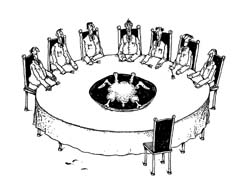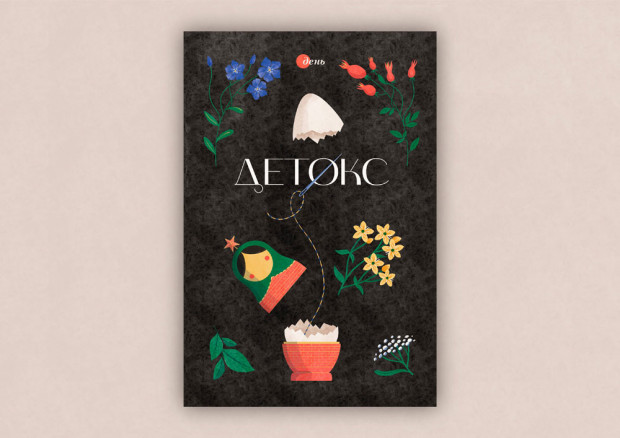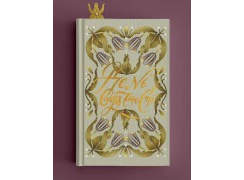Three Peoples Cannot Have the Same Fatherland

Readers’ letters show that the Slavic forum held recently in Moscow caused a negative response in most cases as yet another attempt to bring forth the pan-Slavic idea currently reduced in geographic and political space to three post-Soviet countries. The Day has broached the subject in the past. This time we offer an historical view on the idea of Slavic unity within a single state, contributed by Oleksiy K UZMUK of Kyiv.
Certain political quarters in Russia are once again playing the political card of the Slavic peoples uniting into a single state. Considering today’s process of uniting Europe, the idea might seem attractive enough, except the coercive method of bringing about this unity, for the inevitable result would be a polity dominated by Russian culture. The European method is fundamentally different, in that it relies on a system of moral and ethical values, mostly originating from Europe.
With all their outward similarity of languages and cultures, the Eastern Slavs are absolutely different in their approaches to social problems and morals. This is only natural, as the age- old history of the rise and fall of the Russian Empire could not help but affect the Russian world outlook. Its impact on the social processes in Russia is still evident. The Ukrainian man in the street has always been wary of the powers that be, willingly delegating the right to form systems of authority to others, yet always retaining the right to uphold his own morals. The differences in Weltanschauung, given the overall similarity of cultures, could only result from long-lasting processes heavily impacting daily life, folkways, and family relationships.
At first, I found it hard to comprehend why a woman and housewife was formally referred to as druzhyna [lit., wife, but also meaning “lifelong friend”] in Ukraine and supruga in Russia, from the word supryaga or upryazhka [meaning harness]. In Poland, it is malszonka. I think the explanation is to be found in our distant past.
Matriarchy was prevalent long before the first states appeared, rooted in the cult of the primal mother, the Queen of Heavens who, in the eyes of many peoples, became the Goddess of the Earth, mother of all living things. This attitude made the woman’s authority rise considerably; women came to dominate society, pushing men to the background. Women not only composed the cultural/spiritual elite, but also acted as lawgivers, physicians, even warriors. They bestowed on plants the divine status of the first mother goddess and learned to distinguish plant varieties, cultivate them, and use them as medicines and food. Men retained their position only as hunters and primitive livestock breeders, where physical strength was an important factor.
Men’s lifestyle was predominantly nomadic, traveling boundless steppes, and in their imagination the image of God was masculine; it was He the Creator. Thus formed the community of nomads in the east, united by a qualitatively different cult.
Both civilizations coexisted in a variety of forms, ranging from hostility to ideological confrontation, but there were also attempts to forge peaceful coexistence, the more so that their religions complemented each other in many respects. This could take the form of merger, as was the case with the territory which is currently our Fatherland. A spiritual union of two deities, male and female, left its trace on the relations between the opposite sexes among human beings, instituting the family. In the man’s eyes, woman was his double, friend, and wife; this alliance, allowed by both religions, acquired a spiritual status, becoming legitimate and lasting.
The merger of both cults was enhanced by the cultivation of new crops sponsored by the temples of the goddess: the wheat and barley brought by itinerant cattlemen from distant lands and associated with the wheat ear symbolizing the Son of God of Light or the Sun and Goddess of the Earth. Both cultures were first grown for purely religious purposes, but with time they became the basis of an established farming business. Small scattered farms at venues of matriarchy, called malanka, started to be cultivated by families uniting into village communities. The latter served as a fine school of labor for posterity, because labor was not just the source of well-being, but also a religious rite. Thus appeared the so-called Slavic Belt separating the patriarchal and matriarchal territories. With time, it begot a new social stratum, working people, Slavs making up the industrial-economic basis of future states and empires.
However, by taking to peaceful labor, our forefathers lost their warrior skill, often falling prey to militant steppe nomads professing extreme patriarchate, with women being men’s property and reckoned with only as procreators. Confrontations were tragic, as in the case with the Poliany community and the horde of Obri or Obori, known as Avars to the Greeks.
The Poliany were a people that had probably absorbed most of the Sun- Earth religious-cultural traditions. They even held sacred the land in which they lived, for it was there they loved one another and lived in accord. The Poliany knew how to breed plants and till their soils, and they also knew about female charms, particularly those of the priestesses of Lada, the goddess born of love between the Heavens and Earth.
The Avars, after overpowering the Poliany men (most of whom would retreat into the northern Finnish forests), suddenly found themselves faced with the Poliany women’s passive resistance. Often, a Poliany woman raped by an Avar would leave him sleeping, set fire to her home and then jump into the fire. However, most Poliany women did not go to such excesses; instead, they would use their feminine skill to get the status of a legitimate wife, albeit younger one — hence the current Polish term malszonka. With time, the Obri moved to Hungary and Poland. It was there the Poliany women could put their talent to the best use, organizing farms like those practiced by their native tribe. They raised their children in the true Poliany spirit and the land newly inhabited by them received its name from them, Polonia or Poland. As for the Polish szlachta gentry, they must have inherited from the Obri their militant spirit and thirst for power.
Poliany men settling in the north also tried to revive the rites and traditions of their now lost homeland, but the land they now inhabited was far less suited for the plow, so they each now wanted a woman of a different stature, physically strong but with an obedient heart, so they could make them into reliably harnessed lifelong assistants, supryaga wives. Those women sired generations of northern Poliany constituting the spiritual nucleus in the process of formation of the Russian nation.
Therefore, the Poles and Russians are indeed related to the Ukrainians, except that we became related to the Russians along the male lines and to the Poles along the female lines. Poles and Russians have always subconsciously sought to return their lost homeland, Malania or Vkrayina, a land “close to paradise.” Yet this is impossible, even if due to the fact that a single people cannot have two Fatherlands, just as three people cannot have one. Ukraine, nevertheless, could be the venue of a SPIRITUAL SLAVIC ALLIANCE, as both the cradle of the Slavic cultures and as a nation that has preserved a negative attitude to secular power, meaning that it shall never abuse it.






